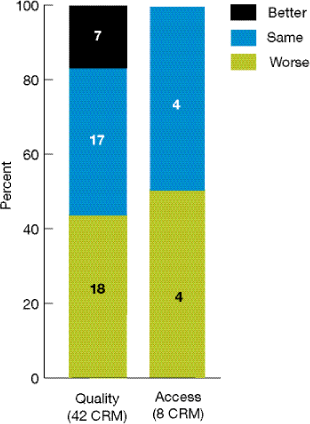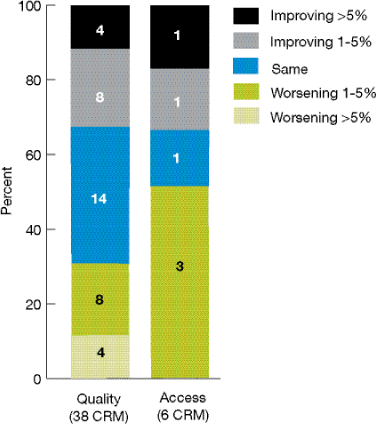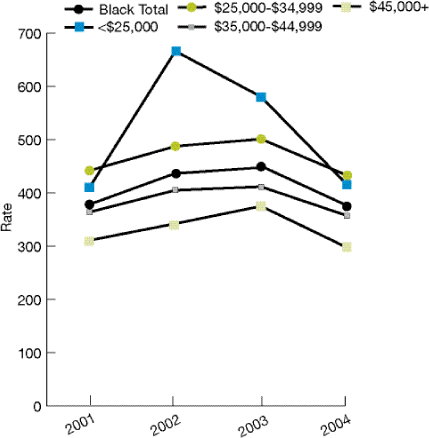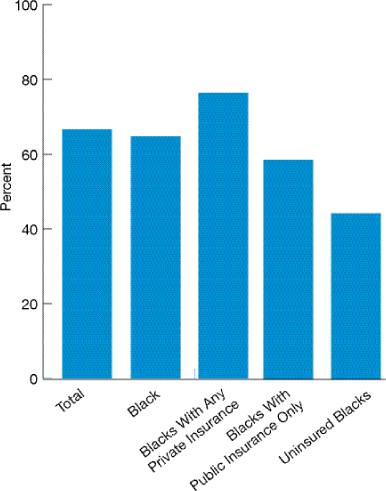Chapter 4. Priority Populations
Contents
Racial and Ethnic Minorities
Low Income Groups
Women
Children
Elderly
Residents of Rural Areas
Individuals With Disabilities and Special Health Care Needs
To examine the issue of disparities in health care, Congress directed the Agency for Healthcare Research and Quality (AHRQ) to produce an annual report to track "prevailing disparities in health care delivery as it relates to racial factors and socioeconomic factors in priority populations." Although the emphasis is on disparities related to race, ethnicity, and socioeconomic status, this directive includes a charge to examine disparities in "priority populations"—groups with unique health care needs or issues that require special attention.
This chapter addresses the congressional directive on priority populations.i Chapters 2 and 3 of this report examine racial, ethnic, and socioeconomic differences in quality of health care and access to health care in the general U.S. population. This chapter focuses on differences within and across priority populations. For example, comparisons are made between Black and White women and between children from low and high income families. This year, the National Healthcare Disparities Report (NHDR) section on low income groups is focused on examining differences in quality of care and access to care by insurance status.
The approach taken in this chapter may help policymakers to understand the impact of racial, ethnic, and socioeconomic differences on specific populations and target quality improvement programs toward groups in greatest need. Appendix D includes detailed tables that allow examination of racial, ethnic, and socioeconomic disparities both in the general population and across priority populations for most measures.
AHRQ's Priority Populations
AHRQ's priority populations, specified by Congress in the Healthcare Research and Quality Act of 1999 (Public Law 106-129), are:
- Minority groups.ii
- Low income groups.iii
- Women.
- Children (age 0-17).
- Elderly (age 65 and over).
- Individuals with special health care needs,iv including individuals with disabilities and individuals who need chronic care or end-of-life health care.
In addition, this legislation directs AHRQ to examine health care delivery in rural areas. Hence, this chapter addresses each of these priority populations as well as residents of rural areas.
i The congressional mandate for the NHDR also identifies populations living in inner city areas as a priority population. However, currently no data are available to support findings for this population.
ii Racial categories include White, Black, Asian, Native Hawaiian or Other Pacific Islander (NHOPI), American Indian or Alaska Native (AI/AN), and more than one race. Ethnic categories are Hispanic or Latino, non-Hispanic White, and non-Hispanic Black.
iii In the NHDR, low income refers to poor people. Thresholds for income categories—poor, near poor, middle income, and high income—vary by family size and composition and are updated annually by the U.S. Bureau of the Census. For example, in 2005 the Federal poverty threshold for a family of two adults and two children was $19,806.
iv Individuals with special health care needs include children with special health care needs (CSHCN). CSHCN are defined as those who have or are at increased risk for a chronic physical, developmental, behavioral, or emotional condition and who also require health and related services of a type or amount beyond that required by children generally.
Return to Contents
How This Chapter Is Organized
This chapter provides the most recent information available on racial, ethnic, and income differences in quality and access for priority populations. It is presented in the following order:
- Racial and ethnic minorities.
- Low income groups (focus on the uninsured).
- Women.
- Children.
- Elderly.
- Residents of rural areas.
- Individuals with special health care needs.
To avoid repetition of findings from previous chapters on race, ethnicity, and socioeconomic status, the first two sections summarize quality of and access to health care for racial and ethnic minorities and low income groups.
Subsequent sections focus on the remaining priority populations and examine disparities in care within each population group and changes in disparities over time. To present this greater detail, these sections highlight a small number of measures. Measures for each priority population were selected with the assistance of members of the Interagency Work Group and AHRQ experts for particular populations. For smaller priority populations, measure selection was often driven by available sample sizes. When possible, measures were selected to encompass multiple components of health care need, such as preventive services, treatment of acute illness, management of chronic disease, and access to health care. Results for all measures are found in the detailed appendix tables.
The measures discussed in this chapter follow.
| Section |
Measure |
| Blacks or African Americans |
Pediatric asthma admissions
Breast cancer screening |
| Asians |
Breast cancer screening
Diabetes care
Uninsurance
Influenza vaccinations
Emergency department visits |
| American Indians and Alaska Natives |
Diabetes hospitalizations
Hospitalizations for perforated appendix |
| Hispanics or Latinos |
Breast cancer screening
Diabetes care
Uninsurance
Emergency or urgent care for asthma |
| Recent Immigrants and Limited-English-Proficient Populations |
Tuberculosis therapy
Poor communication with health providers
Uninsurance
Breast cancer screening
Diabetes care
Usual source of care |
| Low Income Groups |
Breast cancer screening
Counseling to parents about children's healthy eating
Counseling to obese adults about exercise
Dental care |
| Women |
Prenatal care/maternal health
Recommended care for heart attack
New AIDS cases
HIV testing during prenatal care
Usual source of care |
| Children |
Vaccinations
Counseling about overweight
Counseling about healthy eating
Dental care
Hospital admissions for pediatric gastroenteritis
Hospital admissions for pediatric asthma
Care for illness or injury as soon as wanted
Poor communication with health providers
Health insurance
Mental health care |
| Elderly |
Influenza vaccination, dental care
Delayed care due to cost |
| Residents of Rural Areas |
Prenatal care/maternal health
Inpatient deaths from heart attack
Health insurance |
| Individuals With Special Health Care Needs |
Adults
Counseling obese adults about exercise
Inappropriate medication use by the elderly
Delayed care
Children
Care for illness or injury as soon as wanted
Communication with health providers |
It should be noted that this chapter does not provide a comprehensive assessment of health care differences in each priority population. Most of the measures tracked in the NHDR were selected to be applicable across many population groups; only a few, such as immunizations among children and screening for breast cancer among women, were specific to particular groups. These general measures overlook some important health care problems specific to particular populations. For example, people with disabilities may face barriers in getting access to care and experience differences in quality of care that are not captured by data because of the limitations in the survey instruments. In addition, national data may not address key health issues for specific population groups, and it is not always possible to generate reliable estimates for many smaller groups such as Native Hawaiians or Other Pacific Islanders and American Indians and Alaska Natives. Instead, this chapter should be seen as a starting point, identifying some problem areas and indicating gaps in current data and understanding.
Return to Contents
Racial and Ethnic Minorities
In 2000, about 33% of the U.S. population identified themselves as members of racial or ethnic minority groups.1 By 2050, it is projected that these groups will account for almost half of the U.S. population. For 2005, the U.S. Census Bureau estimated about 37.9 million Blacks or African Americans2 (12.8% of the U. S. population);3 over 42.7 million Hispanics or Latinos (14%);2 almost 12.7 million Asians (4.3%); 517,600 Native Hawaiians or Other Pacific Islanders (0.2%); and over 2.9 million American Indians and Alaska Natives (1.0%), of whom 38% reside on Federal trust lands.4 Racial and ethnic minorities are more likely than non-Hispanic Whites to be poor or near poor.4 In addition, Hispanics, Blacks, and some Asian subgroups are less likely than non-Hispanic Whites to have a high school education.5
Racial and ethnic minority populations presented in the NHDR often include diverse subgroups. For example, the Asian and Pacific Islander classification represents individuals originating from more than 100 different countries and territories. According to the 2000 Census data, nearly 4% of Blacks were foreign born. Among foreign-born Blacks, about 84% were from two regions, the Caribbean and Africa, while 12% were from Central and South America.6 American Indian populations encompass numerous tribal nations. Hispanics include large numbers of recent immigrants as well as long-term residents from 20 Spanish-speaking countries across the Americas and Spain. Increases in Hispanic subpopulations together with the aging of the Hispanic population overall, which as a group is younger than the U.S. average, present a timely opportunity to focus on health care and health care disparities for Hispanics.7
In previous chapters of the 2007 NHDR, health care differences by racialv and ethnicvi categories as defined by the Office of Management and Budget and used by the U.S. Census Bureau are described.8 In this section, quality of and access to health care for each minority group are summarized to the extent that statistically reliable data are available for each group.vii Criteria for importance are that the difference is statistically significant at the alpha = 0.05 level, two-tailed test, and that the relative difference is at least 10% different from the reference group when framed positively as a favorable outcome or negatively as an adverse outcome. Access measures focus on facilitators and barriers to health care and exclude health care utilization measures.
In addition, changes in differences related to race and ethnicity over time are examined in this section. For each core report measure, racial, ethnic, and socioeconomic groups are compared with a designated comparison group at different points in time. Consistent with Healthy People 2010, disparities are measured in relative terms as the percent difference between each group and a comparison group; changes in disparity are measured by subtracting the percent difference from the comparison group at the baseline year from the percent difference from the comparison group at the most recent year. The change in each disparity is then divided by the number of years between the baseline and most recent estimate to calculate change in disparity per year. Core report measures (Table 1.2) for which the relative differences are changing less than 1% per year are identified as staying the same. Core report measures for which the relative differences are becoming smaller at a rate of more than 1% per year are identified as improving. Core report measures for which the relative differences are becoming larger at a rate of more than 1% per year are identified as worsening. Changes of greater than 5% per year are also differentiated from changes of between 1% and 5% per year in some figures.
v Races include Black or African American, Asian, Native Hawaiian or Other Pacific Islander, American Indian or Alaska Native, White, and persons of multiple races.
vi Ethnicity differentiates Hispanics and non-Hispanics. Among non-Hispanics, this report identifies non-Hispanic Whites and non-Hispanic Blacks.
vii Data are presented for each minority group except for persons of multiple races due to unreliable estimates for this group.
As in previous NHDRs, this section includes information on programs and issues that may affect racial and ethnic disparities. The assessment of disparities faced by American Indians and Alaska Natives (AI/ANs) includes information on the approximately 45% of American Indians and Alaska Natives who obtain care from Indian Health Service (IHS) facilities and tribal facilities that receive IHS funding.
In interpreting findings for racial and ethnic minorities, readers should note that considerable gaps in information for some racial and ethnic minorities exist, which limit the NHDR's ability to identify the current state of disparities for some groups. Gaps can relate to insufficient data to produce reliable estimates or, when estimates are possible, to inadequate power to detect large differences. For example, of core report measures of quality, it is rarely possible to provide estimates for Native Hawaiians or Other Pacific Islanders (NHOPIs) and persons of more than one race. For Asians, only about two-thirds of core report measures of quality support analyses; and for AI/ANs, only about half of these same measures support analyses. In addition, many data sources changed racial classifications for Asians and NHOPIs to adhere to new Federal standards in 2003. This change has further constrained the ability to perform trend analyses for these groups. Chapter 1, Introduction and Methods, and the summary section at the end of this report present more detailed descriptions of current data limitations and ways in which data are gradually improving.
Below is a summary of the percentage of measures that need improvement. This table includes only measures for which data are available for all racial and ethnic populations included in the report (except NHOPI due to data limitations from most sources). In showing differences in disparities between racial and ethnic groups, it points to the different health care issues that each group may face and, therefore, possible priority areas for each group.
Table 4.1. Percentage of core quality and access measures that need improvement for various racial/ethnic groups
| Group |
Reference group |
Percentage of core measures not improving
(n = number of measures that could be tracked) |
| |
|
Quality of care |
Access to care |
Black
Asian
AI/AN
Hispanic |
White
White
White
Non-Hispanic White |
- 68 (n = 38)
- 59 (n = 27)
- 65 (n = 17)
- 60 (n = 35)
|
- 67 (n = 6)
- 50 (n = 6)
- 50 (n = 4)
- 67 (n = 6)
|
Note: Need improvement is defined for quality measures as population received about the same or worse quality of care as Whites or non-Hispanic Whites; and for access measures as population had about the same or worse access to care as Whites or non-Hispanic Whites. Percentages are based on a subset of core measures that have data for these groups. Some measures include data for all ages and some are age-group specific. Refer to measure descriptions and appendix tables for more information. Baseline year and most recent year are not the same for all measures, depending on source of data.
AI/AN = American Indian or Alaska Native.
For each racial or ethnic group, Table 4.2 highlights the core measures with gaps that are increasing (i.e., getting worse) for the group compared with its reference group. Table 4.3 shows disparities in access to health care that are getting worse for selected groups.
Table 4.2. Core measures that are getting worse for group compared with reference group
| Group |
Preventive services |
Acute illness treatment |
Chronic disease management |
Timeliness |
Patient centeredness |
| Black vs. White |
|
|
Hospital admissions for lower extremity amputations in patients with diabetes.
Hospital admissions for pediatric asthma. |
|
Adults with provider communication problems. Children whose parents report provider communication problems. |
| Asian vs. White |
Adults age 65 and over who ever received pneumococcal vaccination. |
|
|
Appropriate timing of antibiotics received by adult Medicare patients having surgery.
Illness/injury care as soon as wanted. |
Adults with provider communication problems. |
| American Indian/Alaska Native vs. White |
|
Tuberculosis patients who complete a curative course of treatment. |
Hemodialysis patients with appropriate urea reduction ratio.
Long-stay nursing home residents who were physically restrained.
Home health care patients who had to be admitted to the hospital. |
|
|
Hispanic vs.
non-Hispanic White |
Obese patients age 18 and over given advice about exercise.
Adults age 65 and over who ever received pneumococcal vaccination. |
|
Hospital admissions for lower extremity amputations in patients with diabetes.
Hospital admissions for pediatric asthma. |
|
Adults with provider communication problems.
Children whose parents report provider communication problems. |
| Poor vs. high income |
|
Hospital admissions for pediatric gastroenteritis. |
Adults with diabetes who had 3 major exams in past year.
Hospital admissions for lower extremity amputations in patients with diabetes.
Hospital admissions for pediatric asthma.
|
Illness/injury care as soon as wanted. |
Adults with provider communication problems. |
Note: "Asian" includes "Asian or Pacific Islander" when information is not collected separately for each group. The time period for this table is the most recent and oldest years of data used in the NHDR. Measures with the highest annual percentage change in the direction of "getting worse" are shown here. A blank cell indicates that no disparity in quality of care was getting worse for the group, which could reflect lack of data or small sample sizes for some populations.
Table 4.3. Disparities in access to health care that are getting worse for selected groups
| Group |
Access to health care |
| Black vs. White |
Persons who have a usual primary care provider. |
| Asian vs. White |
|
| American Indian/Alaska Native vs. White |
People under age 65 uninsured all year. |
| Hispanic vs. non-Hispanic White |
Persons who have a specific source of ongoing care. |
| Poor vs. high income |
People under age 65 uninsured all year.
Persons who have a specific source of ongoing care. |
Note: "Asian" includes "Asian or Pacific Islander" when information is not collected separately for each group. The time period for this table is the most recent and oldest years of data used in the NHDR. A blank cell indicates that no disparity in access to care was getting worse for the group, which may reflect lack of data or small sample sizes for some populations.
Return to Contents
Blacks or African Americans
Previous NHDRs showed that Blacks had poorer quality of care and worse access to care than Whites for many measures tracked in the reports. Findings based on core report measures (Table 1.2) of quality and access to health care are shown below.
Figure 4.1. Blacks compared with Whites on measures of quality and access

Better = Blacks receive better quality of care or have better access to care than Whites.
Same = Blacks and Whites receive about the same quality of care or access to care.
Worse = Blacks receive poorer quality of care or have worse access to care than Whites.
CRM = core report measures (Table 1.2).
Note: Data presented are the most recent available.
- For 18 of the 42 core report measures of quality, Blacks had poorer quality of care than Whites (Figure 4.1). Black-White differences ranged from Blacks being over 10 times as likely as Whites to be diagnosed with AIDSviii to Blacks being 15% less likely than Whites to be admitted to the hospital for pediatric gastroenteritis. The median difference over all 42 core report measures was 16%.
- For 4 of the 8 core report measures of access, Blacks had significantly worse access to care than Whites. Differences ranged from Blacks being 25% more likely than Whites to have communication problems with their providers to Blacks being 2% less likely than Whites to delay medical care due to financial reasons. The median difference over all 8 core report measures was 13%.
viii Although differences in developing AIDS do not necessarily translate into differences in quality of care, early and appropriate treatment of HIV infection can delay progression to AIDS.
Figure 4.2. Change in Black-White disparities over time

Improving >5% = Black-White difference becoming smaller at rate greater than 5% per year.
Improving 1-5% = Black-White difference becoming smaller at rate between 1% and 5% per year.
Same = Black-White difference not changing.
Worsening 1-5% = Black-White difference becoming larger at rate between 1% and 5% per year.
Worsening >5% = Black-White difference becoming larger at rate greater than 5% per year.
CRM = core report measures (Table 1.2).
Note: The time period for this figure is the most recent and oldest years of data used in the NHDR. Only 44 core report measures could be tracked over time for Blacks.
- Of core report measures of quality that could be tracked over time for Blacks and Whites, Black-White differences became smaller for 12 measures and larger for 12 measures (Figure 4.2). For 14 measures, Black-White differences did not change over time.
- Of core report measures of access that could be tracked over time for Blacks and Whites, Black-White differences became smaller for 2 measures and larger for 3 measures. For 1 measure, the Black-White difference did not change over time.
Focus on Blacks by Income and Insurance Status
Throughout the report, differences between Blacks and Whites for each measure are discussed. Additional differences stratified by insurance status are discussed here.
Figure 4.3. Pediatric asthma admissions per 100,000 population for Blacks, by median income of patient residence, 2001-2004

Source: Agency for Healthcare Research and Quality, Healthcare Cost and Utilization Project State Inpatient Databases (HCUP SID) disparities analysis file, 2001-2004. The HCUP SID disparities analysis file is designed to provide national estimates using weighted records from a sample of hospitals from 23 States that have 64% of U.S. resident population. Income categories are based on the median income of the ZIP Code of the patients' residence.
Denominator: Children ages 2-17.
- From 2001 to 2004, the gap between Black children living in poor communities and Black children living in high income communities remained the same (Figure 4.3). In 2004, the difference between these two comparison groups was not statistically significant.
- In 2004, the proportion of pediatric hospital admissions for asthma was higher for Black children in communities with median household income of $35,000-$44,999 than Black children living in high income communities (357.1 per 100,000 compared with 297.4 per 100,000).
Figure 4.4. Black women age 40 and over who reported they had a mammogram in the past 2 years, by insurance status, 2005

Source: Centers for Disease Control and Prevention, National Center for Health Statistics, National Health Interview Survey.
Note: Medicare is included in the Public Insurance Only category for this measure.
Reference population: Civilian noninstitutionalized women age 40 and over.
- In 2005, the proportion of Black women age 40 and over who reported having a mammogram in the past 2 years was lower for publicly insured than privately insured women (58.6% compared with 76.3%; Figure 4.4).
- Uninsured Black women were even less likely to have a mammogram in the past 2 years (44.2% compared with 76.3% for privately insured Black women).

